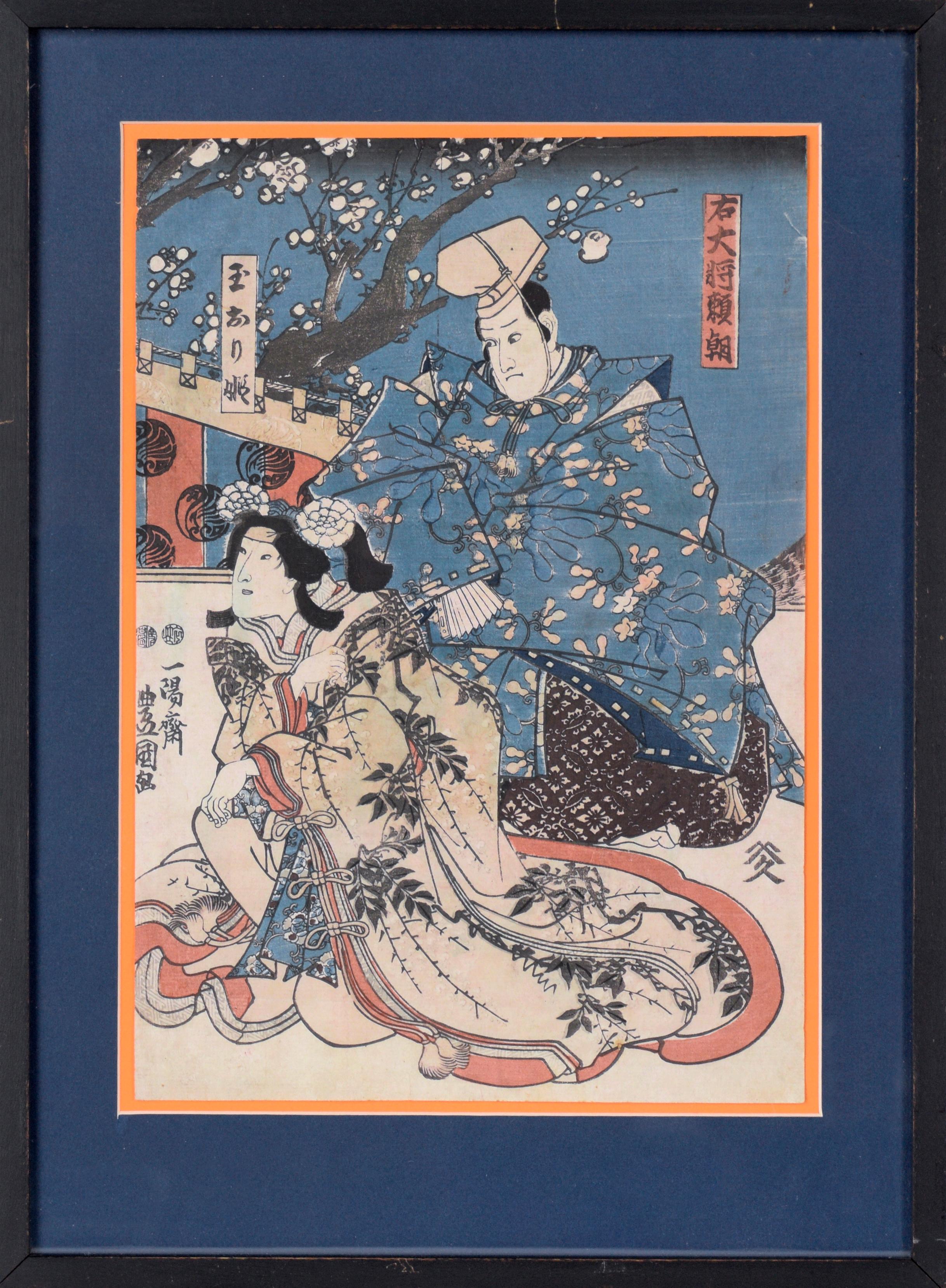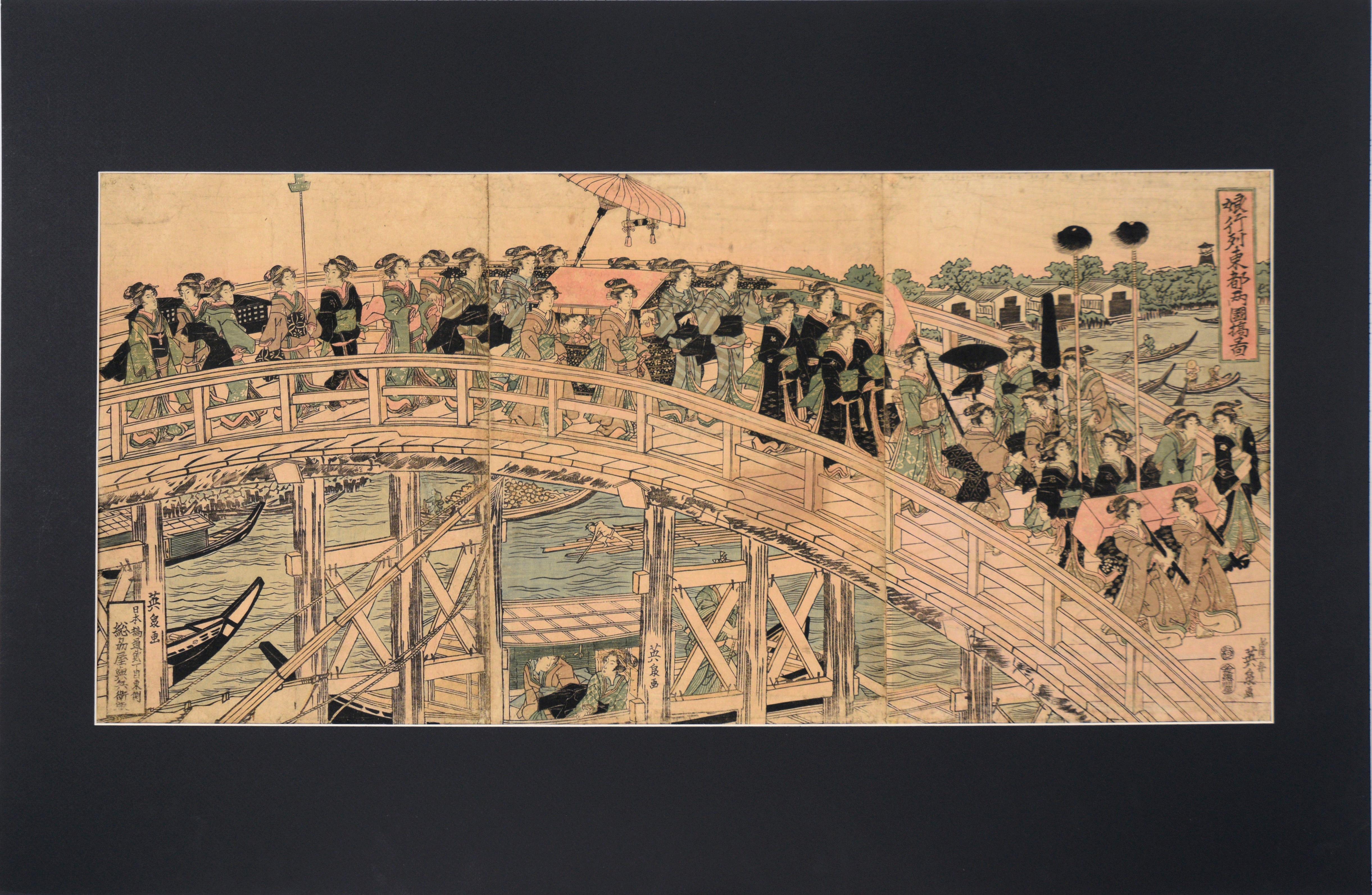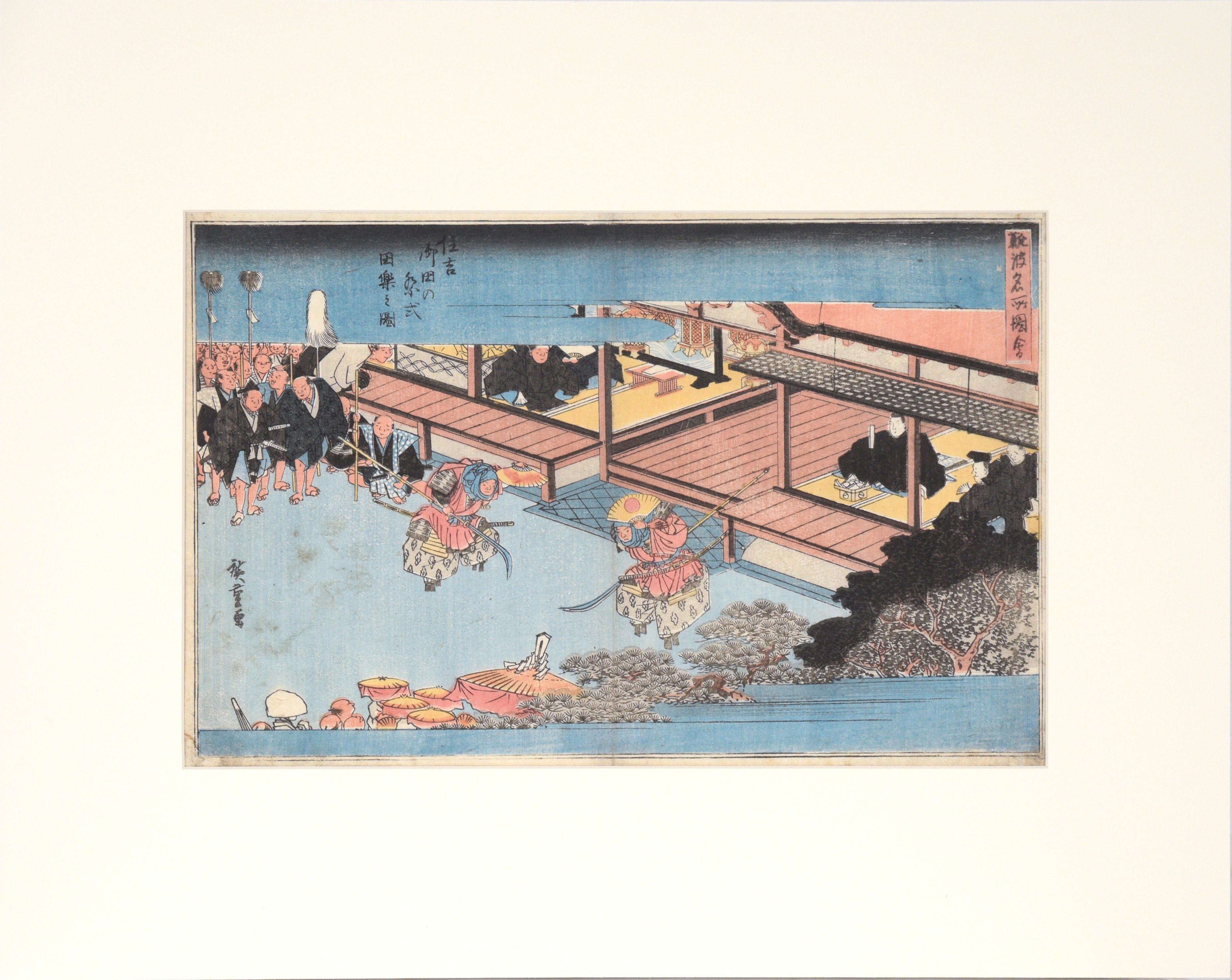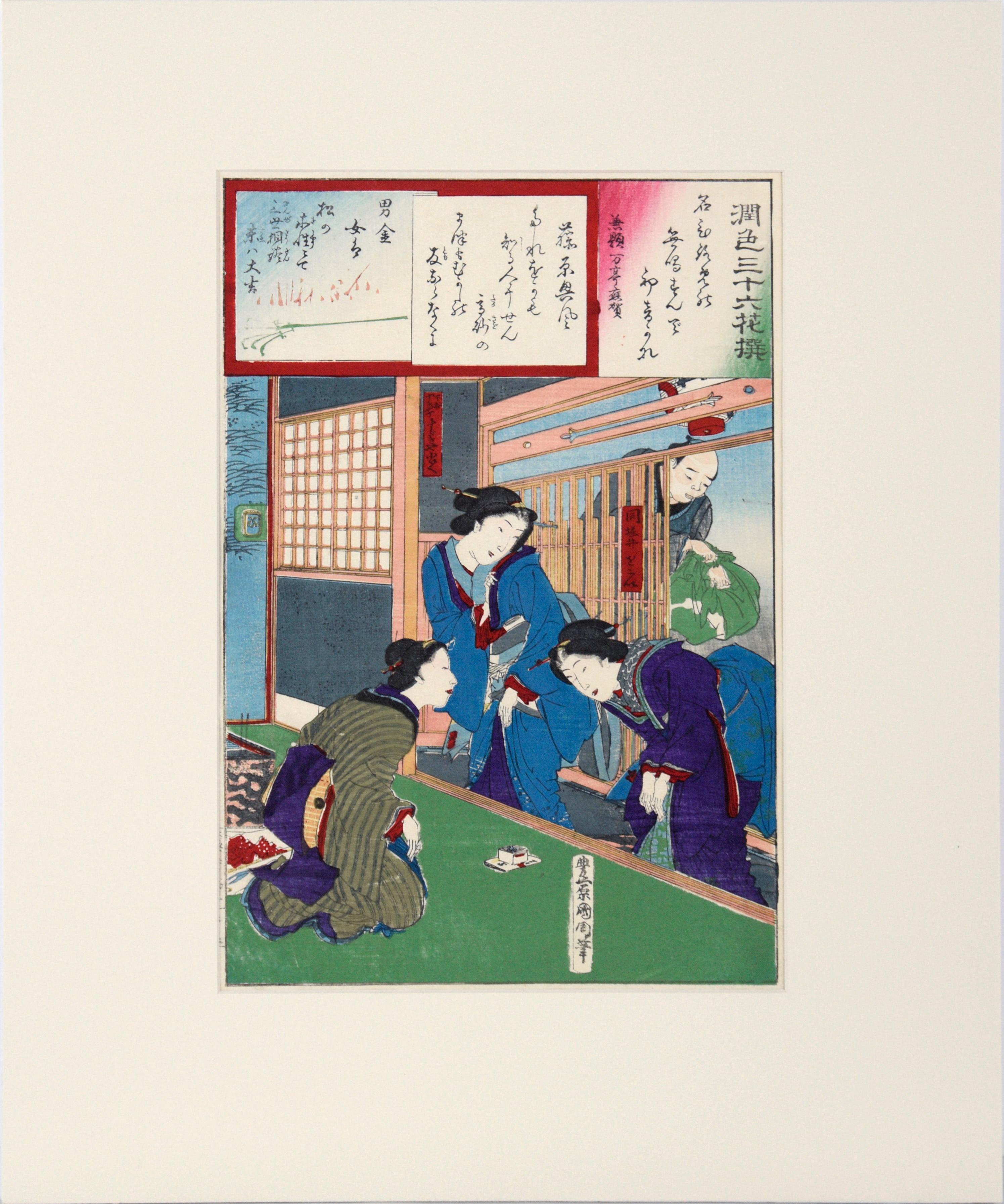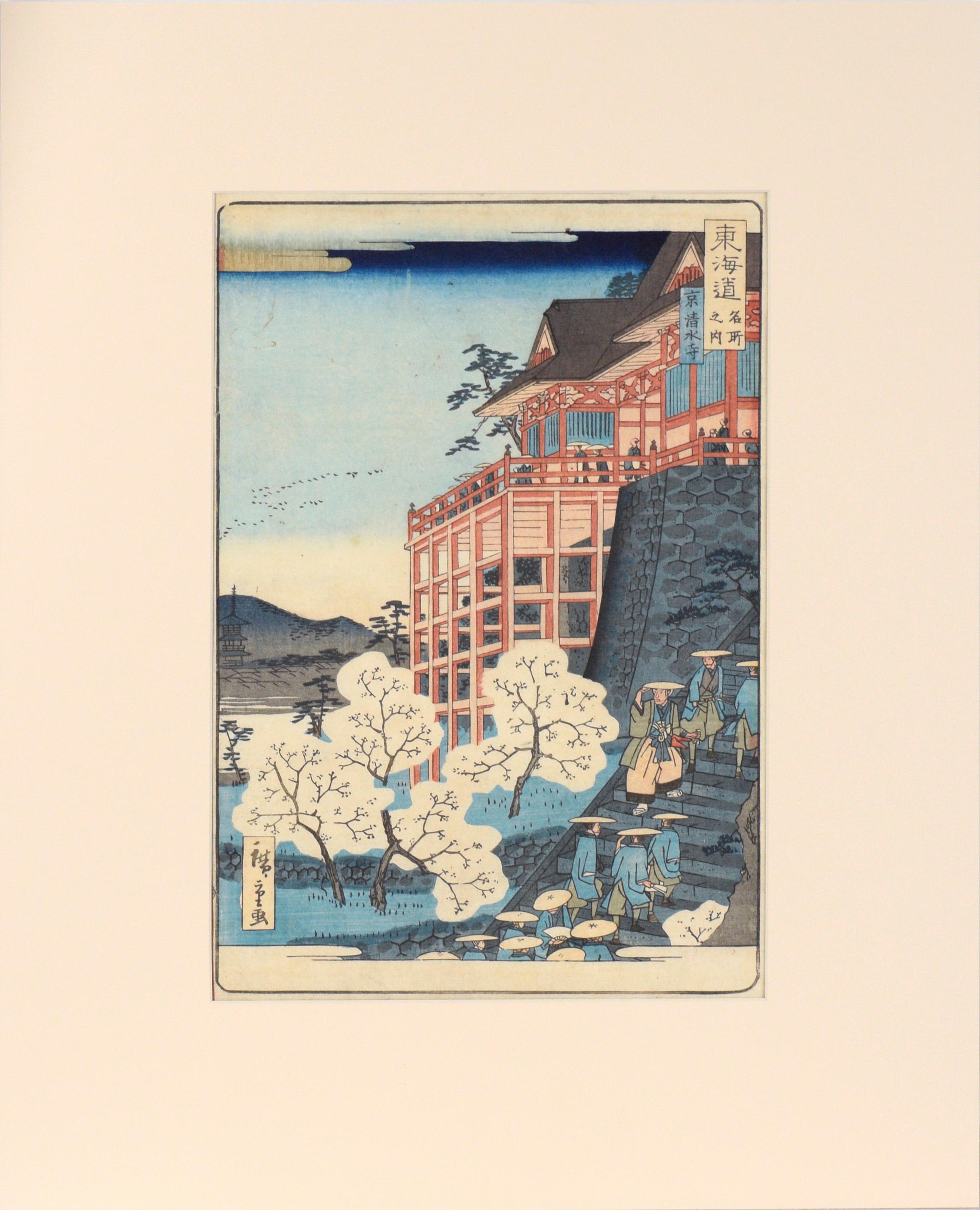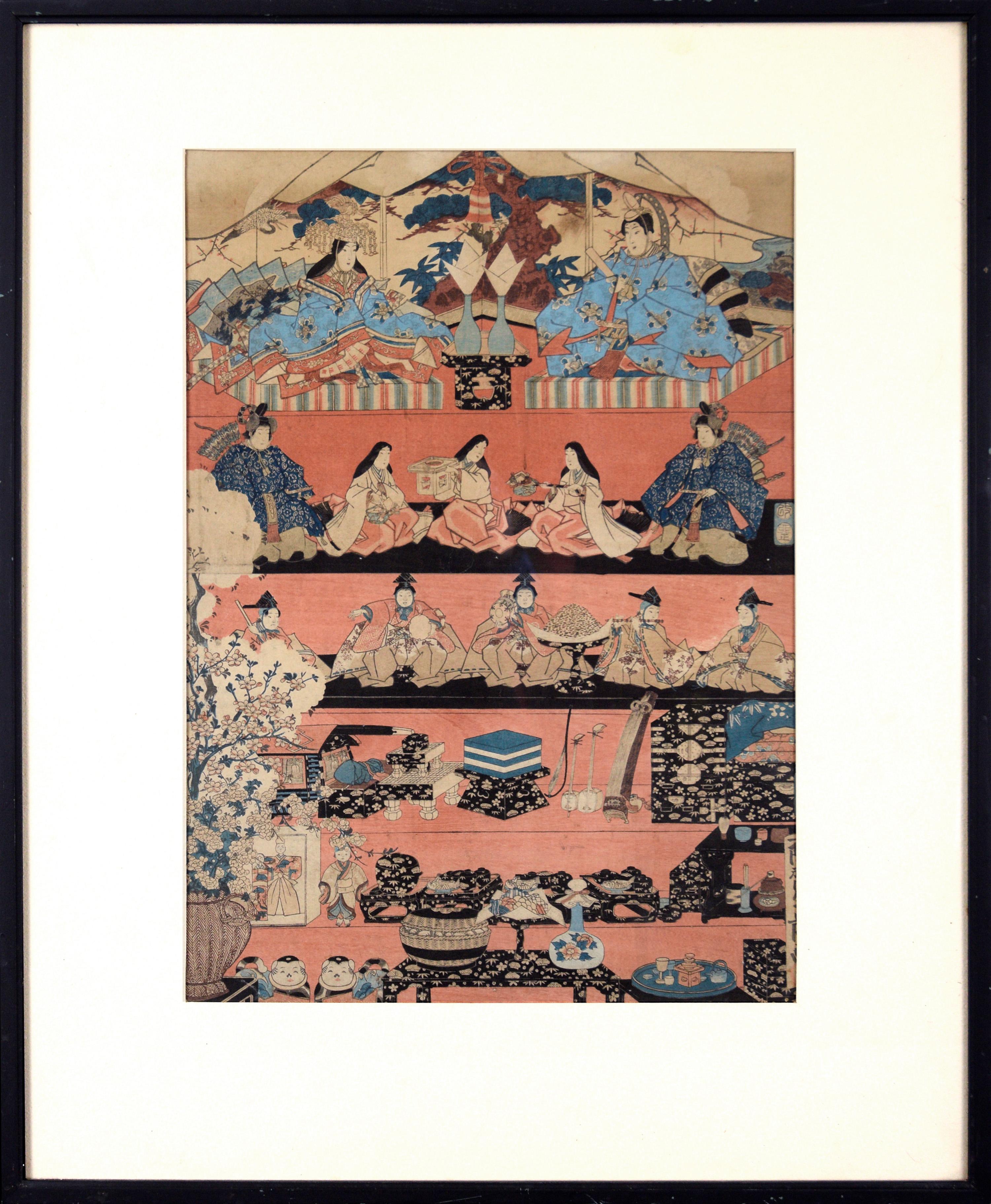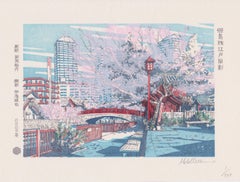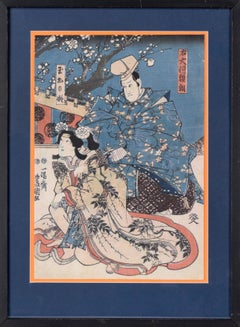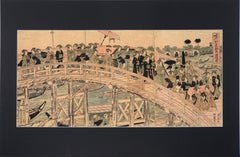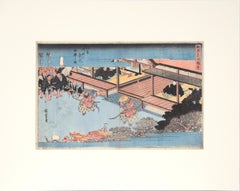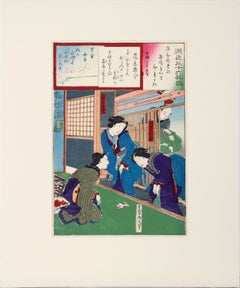Items Similar to Vestiges of Edo in Tsukuda - Winter
Want more images or videos?
Request additional images or videos from the seller
1 of 6
UKIYO-E PROJECTVestiges of Edo in Tsukuda - Winter2020
2020
About the Item
About Vestiges of Edo in Tsukuda (Tsukuda ni Nokoru Edo no Omokage)
Artist: URBANOWICZ Mateusz
Woodcarver: SEKIOKA Senrei III
Printer: ITO Tatsuya
Year: 2020
Our first original landscape ukiyo-e depicting Tsukuda, a neighborhood next to Tsukishima station in the east of Tokyo. This artwork highlights the striking contrast between the modern architecture and historical elements, that co-exist in harmony in Tsukuda today. The Japanese title Tsukuda ni Nokoru Edo no Omokage translates to “the vestiges of Edo in Tsukuda” - the word omokage (vestige) refers to the river, an aspect of old Edo that has continued to exist to this day, despite the fact that other things may have evolved or disappeared with time.
When we trace back the history of ukiyo-e, we can see that there have been many foreign ukiyo-e artists who created important shin-hanga works in the 20th century, such as Paul Jacoulet, Elizabeth Keith, and Noël Nouet. We decided to follow this path in history and welcome Polish artist Mateusz Urbanowicz as the illustrator for this new Tsukuda landscape.
Since ukiyo-e are woodblock prints, it is possible to achieve different colour schemes with a single set of woodblocks, by changing the colour of the inks. We used this unique procedure to create 5 versions, all derived from this set of woodblocks, to express the four seasons (spring, summer, autumn, and winter), as well as a version with the outline only.
Details
Edition: 100 per season and outline
Size: Chuban 7.28 x 9.52 inches (18.5 x 24.2 cm)
Paper: Echizen Kizuki Housho
*Attention
- Each work is signed by the artist.
- Each work is accompanied by a Certificate of Authenticity.
- Once the edition has been fully printed, the same woodblocks will be re-used to hold printing workshops.
- Edition numbers will be chosen randomly.
- Each piece is created by hand, therefore, they may all have subtle differences in size and colour between them. For this reason, at UKIYO-E PROJECT every print is considered unique, aligned with the Edo period philosophy that each ukiyo-e is an “original” piece of work.
- They will be packaged and sent in a specially designed, paper folio.
- The artwork is sold unframed.
- Creator:UKIYO-E PROJECT (2014, Japanese)
- Creation Year:2020
- Dimensions:Height: 7.28 in (18.5 cm)Width: 9.52 in (24.19 cm)Depth: 0.1 in (2.54 mm)
- More Editions & Sizes:Edition of 100Price: $500
- Medium:
- Movement & Style:
- Period:
- Condition:
- Gallery Location:Koto-Ku, JP
- Reference Number:1stDibs: LU2021210461572
About the Seller
No Reviews Yet
Vetted Professional Seller
Every seller passes strict standards for authenticity and reliability
Established in 2014
1stDibs seller since 2022
- ShippingRetrieving quote...Shipping from: Koto-Ku, Japan
- Return Policy
Authenticity Guarantee
In the unlikely event there’s an issue with an item’s authenticity, contact us within 1 year for a full refund. DetailsMoney-Back Guarantee
If your item is not as described, is damaged in transit, or does not arrive, contact us within 7 days for a full refund. Details24-Hour Cancellation
You have a 24-hour grace period in which to reconsider your purchase, with no questions asked.Vetted Professional Sellers
Our world-class sellers must adhere to strict standards for service and quality, maintaining the integrity of our listings.Price-Match Guarantee
If you find that a seller listed the same item for a lower price elsewhere, we’ll match it.Trusted Global Delivery
Our best-in-class carrier network provides specialized shipping options worldwide, including custom delivery.More From This Seller
View AllVestiges of Edo in Tsukuda - Summer
Located in Koto-Ku, 13
About Vestiges of Edo in Tsukuda (Tsukuda ni Nokoru Edo no Omokage)
Artist: URBANOWICZ Mateusz
Woodcarver: SEKIOKA Senrei III
Printer: ITO Tatsuya
Year: 2020
Our first original landscape ukiyo-e depicting Tsukuda, a neighborhood next to Tsukishima station in the east of Tokyo. This artwork highlights the striking contrast between the modern architecture and historical elements, that co-exist in harmony in Tsukuda today. The Japanese title Tsukuda ni Nokoru Edo no Omokage translates to “the vestiges of Edo in Tsukuda” - the word omokage (vestige) refers to the river, an aspect of old Edo that has continued to exist to this day, despite the fact that other things may have evolved or disappeared with time.
When we trace back the history of ukiyo-e, we can see that there have been many foreign ukiyo-e artists who created important shin-hanga works in the 20th century, such as Paul Jacoulet, Elizabeth Keith...
Category
2010s Edo Landscape Prints
Materials
Woodcut
Vestiges of Edo in Tsukuda - Spring
Located in Koto-Ku, 13
About Vestiges of Edo in Tsukuda (Tsukuda ni Nokoru Edo no Omokage)
Artist: URBANOWICZ Mateusz
Woodcarver: SEKIOKA Senrei III
Printer: ITO Tatsuya
Year: 2020
Our first original landscape ukiyo-e depicting Tsukuda, a neighborhood next to Tsukishima station in the east of Tokyo. This artwork highlights the striking contrast between the modern architecture and historical elements, that co-exist in harmony in Tsukuda today. The Japanese title Tsukuda ni Nokoru Edo no Omokage translates to “the vestiges of Edo in Tsukuda” - the word omokage (vestige) refers to the river, an aspect of old Edo that has continued to exist to this day, despite the fact that other things may have evolved or disappeared with time.
When we trace back the history of ukiyo-e, we can see that there have been many foreign ukiyo-e artists who created important shin-hanga works in the 20th century, such as Paul Jacoulet, Elizabeth Keith...
Category
2010s Edo Landscape Prints
Materials
Woodcut
Vestiges of Edo in Tsukuda - Autumn
Located in Koto-Ku, 13
About Vestiges of Edo in Tsukuda (Tsukuda ni Nokoru Edo no Omokage)
Artist: URBANOWICZ Mateusz
Woodcarver: SEKIOKA Senrei III
Printer: ITO Tatsuya
Year: 2020
Our first original landscape ukiyo-e depicting Tsukuda, a neighborhood next to Tsukishima station in the east of Tokyo. This artwork highlights the striking contrast between the modern architecture and historical elements, that co-exist in harmony in Tsukuda today. The Japanese title Tsukuda ni Nokoru Edo no Omokage translates to “the vestiges of Edo in Tsukuda” - the word omokage (vestige) refers to the river, an aspect of old Edo that has continued to exist to this day, despite the fact that other things may have evolved or disappeared with time.
When we trace back the history of ukiyo-e, we can see that there have been many foreign ukiyo-e artists who created important shin-hanga works in the 20th century, such as Paul Jacoulet, Elizabeth Keith...
Category
2010s Edo Landscape Prints
Materials
Woodcut
Vestiges of Edo at Bell Tower - Noon
Located in Koto-Ku, 13
About Vestiges of Edo at Bell Tower (Toki no Kane Edo no Omokage)
Artist: URBANOWICZ Mateusz
Woodcarver: SEKIOKA Senrei III
Printer: ITO Tatsuya
Year: 2021
A former castle town situ...
Category
2010s Edo Landscape Prints
Materials
Woodcut
Vestiges of Edo at Bell Tower - Evening
Located in Koto-Ku, 13
About Vestiges of Edo at Bell Tower (Toki no Kane Edo no Omokage)
Artist: URBANOWICZ Mateusz
Woodcarver: SEKIOKA Senrei III
Printer: ITO Tatsuya
Year: 2021
A former castle town situ...
Category
2010s Edo Landscape Prints
Materials
Woodcut
Vestiges of Edo in Tsukuda - Set of Four Seasons
Located in Koto-Ku, 13
About Vestiges of Edo in Tsukuda (Tsukuda ni Nokoru Edo no Omokage)
Artist: URBANOWICZ Mateusz
Woodcarver: SEKIOKA Senrei III
Printer: ITO Tatsuya
Year: 2020
Our first original landscape ukiyo-e depicting Tsukuda, a neighborhood next to Tsukishima station in the east of Tokyo. This artwork highlights the striking contrast between the modern architecture and historical elements, that co-exist in harmony in Tsukuda today. The Japanese title Tsukuda ni Nokoru Edo no Omokage translates to “the vestiges of Edo in Tsukuda” - the word omokage (vestige) refers to the river, an aspect of old Edo that has continued to exist to this day, despite the fact that other things may have evolved or disappeared with time.
When we trace back the history of ukiyo-e, we can see that there have been many foreign ukiyo-e artists who created important shin-hanga works in the 20th century, such as Paul Jacoulet, Elizabeth Keith...
Category
2010s Edo Landscape Prints
Materials
Woodcut
You May Also Like
Two Actors - Japanese Woodblock by Chikanobu Yoshu
By Toyohara Chikanobu
Located in Soquel, CA
Two Actors - Japanese Woodblock by Toyohara Chikanobu (豊原周延, 1838–1912), better known to his contemporaries as Yōshū Chikanobu (楊洲周延).
Colorful and expressive court scene. Two actors...
Category
1890s Edo Landscape Prints
Materials
Ink, Rice Paper, Woodcut
$700 Sale Price
20% Off
Mitate of a Daimyo's Procession Crossing Ryogoku Bridge - Woodblock Print
By Keisai Eisen
Located in Soquel, CA
Mitate of a Daimyo's Procession Crossing Ryogoku Bridge - Woodblock Print
Woodblock print of a procession by Keisai Eisen (Japanese, 1790–1848). Terrific triptych of a procession of...
Category
Early 19th Century Edo Figurative Prints
Materials
Ink, Rice Paper, Woodcut
Sumiyoshi: Dengaku dance performed during an Onda ceremony - Woodblock Print
By Utagawa Hiroshige
Located in Soquel, CA
Sumiyoshi: Dengaku dance performed during an Onda ceremony - Woodblock Print
Bright woodblock print by Utagawa Hiroshige (Japanese, 1797-1858). In this scene, two dancers with swords and fans are facing each other, in the center of a courtyard. There are spectators surrounding them, including nobles in black clothing on a balcony.
Presented in a new off-white mat with foamcore backing.
Mat size: 16"H x 20"W
Paper size: 9.63"H x 14.5W"
Utagawa Hiroshige (1797-1858, sometimes called Ando Hiroshige) was the second of the two great masters of the Japanese landscape woodblock print...
Category
1830s Edo Figurative Prints
Materials
Ink, Rice Paper, Woodcut
"Enshoku Sanju-roku Kasen" (Thirty-six Enchanting Flowers) Woodblock on paper
By Toyohara Kunichika
Located in Soquel, CA
"Enshoku Sanju-roku Kasen" (Thirty-six Enchanting Flowers) Woodblock on paper
Elegant woodblock print by Toyohara Kunuchika (Japanese, 1835-1900). Three women are in talking with each other inside, while a man waits outside holding a bag of some kind. The colors in this piece are rich and saturated, primarily blues, greens, and purple.
Mat size: 16"H x 20"W
Paper size: 14.75"H x 9.88"W
Born in 1835, Toyohara Kunichika grew up in the Kyobashi district of Edo in the midst of merchants and artisans. In 1848, at age 13, he was accepted as an apprentice into the studio of Utagawa Kunisada I...
Category
1880s Edo Figurative Prints
Materials
Ink, Rice Paper, Woodcut
Kiyomizu Temple, Scenes of Famous Places along Tôkaidô Road - Woodblock on Paper
By Utagawa Hiroshige II
Located in Soquel, CA
Kiyomizu Temple, Scenes of Famous Places along Tôkaidô Road - Woodblock on Paper
Full Title:
Kyoto: Kiyomizu Temple (Kyô Kiyomizudera), from the series Scenes of Famous Places along...
Category
1860s Edo Landscape Prints
Materials
Ink, Rice Paper, Woodcut
"Various Himochi" Wagashi Festival Japanese Woodblock Print by Utagawa Toyokuni
Located in Soquel, CA
"Various Himochi" Wagashi Festival Japanese Woodblock Print by Utagawa Toyokuni
Rare oversized early 19th century 5-tiered woodblock by Utagawa Ichiyosai Toyokuni, (Japan, 1769-1825), a Japanese lord and wife oversee a sekku festival of food, music, and dolls or toys. '"oshi" is the first day of “Mi (Snake)” in the third month of the lunar calendar. This day, known in modern Japan as the Girls' Festival, originated in China as a form of purification ceremony in which water and drinking peach blossom wine were used to drive away evil. Many kinds of hishi-mochi appear in this picture of hina ningyo (dolls associated with Hinamatsuri, or the Girl’s Day) from Omochae.
The custom of eating special dishes at events throughout the year and at milestones in people's lives has existed since ancient times. This paragraph specifically focuses on the annual event called sekku, and life events that involve eating sweets. Joshi is the first day of “Mi (Snake)” in the third month of the lunar calendar. This day, known in modern Japan as the Girls' Festival, originated in China as a form of purification ceremony in which water and drinking peach blossom wine were used to drive away evil. According to the Keiso saijiki, in ancient China, on the third day of the third lunar month, people ate “ryuzetsuhan,” which is the juice of gogyo (Jersey cudweed) mixed with rice flour and nectar. In Japan, there is a record in the Heian period history book Nihon Montoku tenno jitsuroku [839-5] that it was an annual event to make kusamochi using gogyo on the third day of the third month of the lunar calendar, which may have been influenced by Chinese customs.
The tradition of eating kusamochi on the third day of the third month of the lunar calendar continued after that. By the Edo period, however, hishimochi had come to be used as a sweet to serve on the third day of the third month. A picture of a hishimochi is included in the Morisada manko , which we mentioned in Part 1. According to it, hishimochi in the Edo period were often three layers of green-white-green instead of the now common red-white-green. However, it is possible to see from our collection that not all hishimochi were made in this way. Omochae published in 1857, is a good example. Omochae is a type of ukiyoe print...
Category
1820s Edo Figurative Prints
Materials
Ink, Rice Paper, Woodcut
